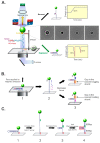The Biochemical Mechanism of Fork Regression in Prokaryotes and Eukaryotes-A Single Molecule Comparison
- PMID: 35955746
- PMCID: PMC9368896
- DOI: 10.3390/ijms23158613
The Biochemical Mechanism of Fork Regression in Prokaryotes and Eukaryotes-A Single Molecule Comparison
Abstract
The rescue of stalled DNA replication forks is essential for cell viability. Impeded but still intact forks can be rescued by atypical DNA helicases in a reaction known as fork regression. This reaction has been studied at the single-molecule level using the Escherichia coli DNA helicase RecG and, separately, using the eukaryotic SMARCAL1 enzyme. Both nanomachines possess the necessary activities to regress forks: they simultaneously couple DNA unwinding to duplex rewinding and the displacement of bound proteins. Furthermore, they can regress a fork into a Holliday junction structure, the central intermediate of many fork regression models. However, there are key differences between these two enzymes. RecG is monomeric and unidirectional, catalyzing an efficient and processive fork regression reaction and, in the process, generating a significant amount of force that is used to displace the tightly-bound E. coli SSB protein. In contrast, the inefficient SMARCAL1 is not unidirectional, displays limited processivity, and likely uses fork rewinding to facilitate RPA displacement. Like many other eukaryotic enzymes, SMARCAL1 may require additional factors and/or post-translational modifications to enhance its catalytic activity, whereas RecG can drive fork regression on its own.
Keywords: DNA repair; DNA replication; HARP; RPA; RecG; SMARCAL1; SSB protein; fork regression; fork reversal; stalled replication fork.
Conflict of interest statement
The author declares no conflict of interest.
Figures






Similar articles
-
Regression of replication forks stalled by leading-strand template damage: I. Both RecG and RuvAB catalyze regression, but RuvC cleaves the holliday junctions formed by RecG preferentially.J Biol Chem. 2014 Oct 10;289(41):28376-87. doi: 10.1074/jbc.M114.587881. Epub 2014 Aug 19. J Biol Chem. 2014. PMID: 25138216 Free PMC article.
-
DNA Helicase-SSB Interactions Critical to the Regression and Restart of Stalled DNA Replication forks in Escherichia coli.Genes (Basel). 2020 Apr 26;11(5):471. doi: 10.3390/genes11050471. Genes (Basel). 2020. PMID: 32357475 Free PMC article. Review.
-
Characterization of the ATPase activity of RecG and RuvAB proteins on model fork structures reveals insight into stalled DNA replication fork repair.J Biol Chem. 2013 Sep 13;288(37):26397-409. doi: 10.1074/jbc.M113.500223. Epub 2013 Jul 27. J Biol Chem. 2013. PMID: 23893472 Free PMC article.
-
RecG and UvsW catalyse robust DNA rewinding critical for stalled DNA replication fork rescue.Nat Commun. 2013;4:2368. doi: 10.1038/ncomms3368. Nat Commun. 2013. PMID: 24013402 Free PMC article.
-
Stalled replication fork rescue requires a novel DNA helicase.Methods. 2016 Oct 1;108:40-7. doi: 10.1016/j.ymeth.2016.06.002. Epub 2016 Jun 6. Methods. 2016. PMID: 27282357 Free PMC article. Review.
Cited by
-
The Inhibitory Effects and Cytotoxic Activities of the Stem Extract of Sarracenia purpurea against Melanoma Cells and the SsbA Protein.Plants (Basel). 2022 Nov 18;11(22):3164. doi: 10.3390/plants11223164. Plants (Basel). 2022. PMID: 36432892 Free PMC article.
-
Looking at Biomolecular Interactions through the Lens of Correlated Fluorescence Microscopy and Optical Tweezers.Int J Mol Sci. 2023 Jan 31;24(3):2668. doi: 10.3390/ijms24032668. Int J Mol Sci. 2023. PMID: 36768987 Free PMC article. Review.
-
The Inhibitory Effects and Cytotoxic Activities of the Stem Extract of Nepenthes miranda against Single-Stranded DNA-Binding Protein and Oral Carcinoma Cells.Plants (Basel). 2023 May 31;12(11):2188. doi: 10.3390/plants12112188. Plants (Basel). 2023. PMID: 37299167 Free PMC article.
References
-
- Lewis J.S., Jergic S., Dixon N.E. The E. coli DNA Replication Fork. Enzymes. 2016;39:31–88. - PubMed
Publication types
MeSH terms
Substances
Grants and funding
LinkOut - more resources
Full Text Sources
Molecular Biology Databases

